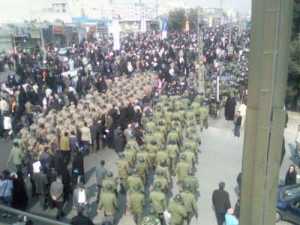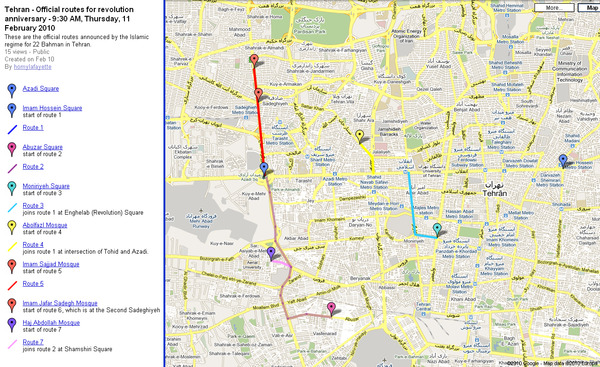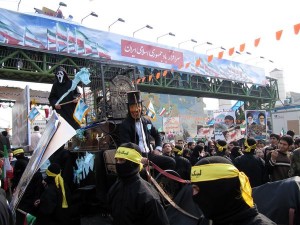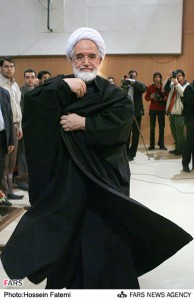
2130 GMT: For What It's Worth. The Supreme Leader's office
has issued a statement saying that Ayatollah Khamenei is jolly happy that today's gathering has shown the unity of Iran in the face of the "arrogance" of Western nations.
2100 GMT: A Correction and a Question. One of the hot stories this morning was that reformist Mohammad Reza Khatami and his wife, Zahra Eshraghi, the granddaughter of Ayatollah Khomeini, had been briefly detained before being released with their promise they would not return to the streets (see 0815 and 0832 GMT).
A reliable EA source from Iran offers this, based on inside information, "The husband and wife were led to their car by security forces in plain clothes to leave the area for their own security."
But that in turn raises a question, "Security from whom?"
NEW Iran on 22 Bahman: Ahmadinejad “Wins Ugly” (This Time)
NEW Iran Document: Interview with Hossein Karroubi (11 February)
NEW Latest Iran Video: The 22 Bahman Protests (11 February — Set 4)
NEW Latest Iran Video: The 22 Bahman Protests (11 February — Set 3)
NEW Latest Iran Video: The 22 Bahman Protests (11 February — Set 2)
NEW Latest Iran Video: The Marches of 22 Bahman (11 February — Set 1)
NEW Latest Iran Video: 22 Bahman – TV Coverage
NEW Latest Iran Video: President Ahmadinejad’s Speech
NEW Iran: A Song for 22 Bahman
NEW Iran: A Beginner’s Guide to The Post-Election Conflict
A Song for Whomever: “Wise Up”
Iran Analysis: On the Eve of 22 Bahman
UPDATED Iran Analysis: The Rafsanjani “Ultimatum” to the Supreme Leader
The Latest from Iran (10 February): Mousavi, Pink Floyd, & 22 Bahman
2000 GMT: We
have just posted our special analysis of 22 Bahman, "Ahmadinejad Wins Ugly (This Time)". I hope it takes discussion beyond today to the political complexities of weeks and months ahead: it is one of the toughest pieces I've ever had to write.
1710 GMT: And Another Re-Assessment. Setareh Sabety sends in her thoughts:
A journalist friend asked me what I thought of today's events and I thought I'd share it with everyone. This is just a tired witnesses assessment of a day that is still not over and where not all reports and clip have yet arrived.
Today did not seem as big as Ashura [27 December] at all, although there are some reports [of continuing protests] and Jaras is tellling people to assemble in the evening. People have been prevented from going near SedaSima (IRIB) or Evin (Prison). The clips show such a huge lack of coordination and street-level leadership. The students that seemed to do the organizing in 16 Azar (7 December) are now all in jail it seems. So unless dramatic new footage comes in or the scattered protests are prolonged into the night, then it is a slight disappointment for the greens and not as huge a protest as predicted.
The big points won are 1) the brutal treatment of (Zahra) Rahnavard and (Mehdi) Karroubi gives them more revolutionary stature and 2) the regime did not succeed in outshining the demonstrators because once again it had to resort to violence and not just outnumbering the protesters. The news of the brutality will ruin the image of a populist government that the regime wants to display. This is a regime that prides itself in its ability to rally masses on these occasions. Today it has lost more credibility.
If no further developments or revelations occur, the opposition needs to rethink its strategy of demonstrating on official and permitted days when the regime has time to plan and clamp down on its moves. Also it will become more apparent that in the face of such regime tactics and brutality more organization and leadership is needed. We have lost our fear but we need to know where to go with our new-found courage!
1700 GMT:
Pedestrian passes on a letter from a friend who was at Azadi Square:
The greens made a stupid miscalculation to want to “take over Azadi” and this illusion was further enforced by individuals abroad [e.g., Sazegara]. State security and supporters had taken over the area, and it was impossible to have a significant impact there. I of course did not see the entire city, but the turnout of the greens felt very low. We needed at least 400,000 to show a significant impact, and thus far, it does not feel that way.
This is disastrous. The only real power the greens have had up to now is by showing their numbers on the streets. Now if with their two week campaign of terror, they’ve actually managed to get everyone to stay home, they will start putting even more pressure on activists and opposition groups … the few who are left out of prison that is.
I feel nauseated, and very scared.
1655 GMT: We have
posted Tehran Bureau's interview with Hossein Karroubi, the son of Mehdi Karroubi, about the attack on his father's entourage, the arrest of his brother, and the events of 22 Bahman.
1600 GMT: In addition to the Shiraz arrests (1500 GMT), Rah-e-Sabz reports
more than 100 arrested in Mashhad.
1540 GMT:
Rah-e-Sabz says
clashes continue in parts of Tehran, including Arya Shahr and Ferdows Boulevard.
1500 GMT:
Rah-e-Sabz is reporting that
more than 20 people were arrested in Shiraz today.
1450 GMT: Mousavi's Day.
Kalemeh reports that Mir Hosein Mousavi tried to join the rally with people on Azadi Street when plainclothes militia, special forces, and Government supporters with batons surrounded him.
1415 GMT:
Kalemeh is reporting that Zahra Rahnavard, the wife of Mir Hossein Mousavi, was beaten in Sadeghieh Square by a group of basijis. People helped her scape by making a human chain around her.
No indication if Mir Hossein Mousavi was present.
1340 GMT: MediaWatch. Islamic Republic News Agency, down yesterday,
is back on-line but
Fars News is out of action.
1251 GMT: Well, That Settles That. Press TV's website
tries to put everything in order in a few sentences:
Millions of Iranians across the country have taken to the streets to celebrate the 31st anniversary of the victory of the Islamic Revolution....In the capital Tehran, an extraordinarily high number of people from all walks of life marched across the city and gathered at Azadi (Freedom) Square to take part in the festivities. They were carrying banners denouncing the enemies of the country.... A few hundred of supporters of Iran's defeated presidential candidates also rallied in Tehran.Press TV's broadcast coverage, which now features nuggets such as a tourist from Brazil and vistor from "Oregon" being surprised and amazed at the pro-Government crowds, is presenting the opposition rallies with shots of a few people milling about in a square in western Tehran. Snuck in is a reference to both Mehdi Karroubi and Mir Hossein Mousavi being seen at the demonstrations.
1250 GMT: Service Announcement. Remember, folks, if everything is running too slow here, we have set up
a back-up site for the LiveBlog.
1240 GMT: How Big Was the Security Presence to Prevent a March In Tehran? Have a look at our thumbnail picture from Sadeghiyeh Square, which was to be the start point for a move on Azadi Square and which was where Mehdi Karroubi was turned back.
1230 GMT: Karroubi's Son on the Attack. Hossein Karroubi, son of key opposition figure Mehdi Karroubi, has given details of the assault on his father's entourage this morning. In an interview with Deutsche Welle, Hossein Karroubi declared, "I witnessed the most brutal treatment of people in the past eight months today."
1225 GMT: Yes, Hashemi Was There. Iranian Labour News Agency runs the picture (see left) that proves former President Hashemi Rafsanjani was at the official rally today.
1210 GMT: The State of Play. In Tehran, it is a case of the regime's one-off Big Bang with the Azadi Square rally vs. the smaller but still important fireworks that have occurred throughout the capital and will continue through the day.
Elsewhere, we are now ready to confirm opposition demonstrations in Isfahan, Mashhad, Ahvaz, and Shiraz.
Peyke Iran has a summary of clashes in Tehran and Isfahan.
1145 GMT: EPersian radio --- a source that we treat with caution because claims can be exaggerated --- reports that the crowd in Tabriz is chanting: "Today is day of blood; Yazid (the caliph who killed Imam Hussein; take your pick who the modern equivalent is) will have to go!"
1135 GMT: Government forces are mobilized against
protesters gathering on Yadegar Imam Road.1130 GMT: Member of Green movement in Shiraz: heavy security presence,
at least 20 people arrested.Mehdi Karoubi's son confirms to CNN his father was attacked. Doctor treating him for tear gas burns to his eyes.
1125 GMT:
Female protesters arrested in Vali Asr and Haft-e Tir.1110 GMT: There are
many injuries in Esfahan.1100 GMT:
Clashes have now spread to the northern parts of Tehran.1045 GMT: What We're Watching. Clashes continue across Tehran, especially in the north of the city. This is likely to be a long day, and no predictions should be made at the moment.
Scott Lucas is off to do BBC World just after 11:30. Tricia Sutherland and Ali Yenidunya will be minding the EA shop.
1015 GMT:
Clashes are escalating at Amir Abad, close to the main Tehran University dormitories.
1005 GMT: North Tehran is
the scene of "sporadic and at times heavy" clashes, especially at Vanak Square. That is notable, since Vanak had been relatively free of clashes in demonstrations in November and December, including Ashura.
1000 GMT: Farda News is reporting that
former President Hashemi Rafsanjani participated in the rally today at Enghelab and Palestine Streets.
0940 GMT: The mainstream site Mardomak is calling the security forces on Tehran's streets "akin to a military regime".
0920 GMT: Resources To Keep By Your Side. For those taking notes, an activist
has posted a full paraphrase --- "10,834 characters, likely filled with typos, and relatively boring" --- of Ahmadinejad's speech.
And here is the
map of the action today in Tehran:

0905 GMT: To Prove Our Analysis. An example of the hit-and-run confrontations
comes from Rah-e-Sabz, which reports clashes between security forces and people trying to reach Azadi Square, as the crowds chant "Death to Dictator" and "Death to Khamenei".
Of course, none of this is making it onto State media, whose propaganda strategy is in overdrive. All of their coverage is focused on the rally in Azadi Square, with the theme being "Iran v. the West" (in other words, no mention as well as no images of internal conflict). Press TV is trotting on "analyst" after "analyst" talking about resistance to Western domination --- one example is the Beirut-based Franklin Lamb.
Two questions: 1) how long can this regime effort last, if the crowds have done their bit and are ready to go home? 2) what happens for the day, as opposition groups (whose size we cannot yet estimate) regroup and marches at different points through Tehran, even as the security forces try to prevent a single, large demonstration?
0900 GMT: Meanwhile, Back to the Real Story. So far, this morning is a repeat of the mornings of other protest days. While the regime tries to hold its showpiece rally, the priority of security forces is to prevent any mass gathering of opposition.
So the running violence throughout the capital is of Iranian security forces pushing back at crowds as they move towards squares. The most dramatic examples was the aggression against the entourages of Mehdi Karroubi and Mohammad Khatami, but the episodes is being repeated in numerous places.
0855 GMT: The Ahmadinejad Showpiece. President's speech was 1 hour, 15 minutes, but you could pretty much wrap it up in the snippets we've posted below.
Key take-away: Ahmadinejad was almost entirely focused on the "external", with Great Iran v. Duplicitous/Evil/Scheming "West". He avoided the internal issues.
Press TV has followed the script, paying particular attention to the "20% uranium declaration" and the nuclear issue.
How does this play, not only with the "Iranian people" but with the opposition and his critics "within the establishment"? Wait and see.
0832 GMT: Fereshteh Ghazi have confirmed that reformist leader Mohammad Reza Khatami and his wife, Zahra Eshraghi (the granddaughter of Ayatollah Khomeini), have been released after a brief detention (see 0815 GMT). They have been warned not to return to the streets.
0830 GMT: President Ahmadinejad still going on about Iran v. The World: "Iran does not welcome confrontation....Obama should make great changes", etc., etc.
0827 GMT:
Rah-e-Sabz now carries
the report of Ali Karroubi's arrest (see 0805 GMT).
0825 GMT: And Ahmadinejad's Big Declaration? "The first batch of 20% uranium has been produced already."
0815 GMT:
Rah-e-Sabz is claiming that Mohammad Reza Khatami, first Secretary-General of the reformist Islamic Iran Participation Front (and not to be confused with former President Khatami), and his wife, Zahra Eshraghi, the granddaughter of Ayatollah Khomeini, have been arrested. (http://www.rahesabz.net/story/10019/)
0810 GMT: That Ahmadinejad Speech. "World powers need us more than we need them."
0805 GMT: Urgent --- Ali Karroubi, son of Mehdi Karroubi has been arrested. The news has been confirmed by his brother, Hossein Karroubi.
0757 GMT: And Khatami? Parleman News is reporting that former President Mohammad Khatami was present in marches between Zanjan St and Azadi Square, supported by loud chants, but he was soon forced to pull back and leave after pressure from pro-Government force. (
http://www.parlemannews.ir/index.aspx?n=8416)
0749 GMT: The Karroubi Attack. We are treated as confirmed, given the report from Fereshteh Ghazi on her Facebook page:
Karroubi was subject to aggression on Ashrafi Esfahani Street. Batons and "coloured bullets" were used to attack his bodyguards. Windows of his car smashed. He was forced to go back home in someone else's car. Karroubi was unscathed but unable to proceed."
Rah-e-Sabz also reports.0748 GMT: More Ahmadinejad: "Domination of the world depends on control of energy. Imperialist Britain managed to subjugate most of the world in its empire through the cheap Middle Eastern energy. The engines of war were successful becuase they extracted and appropriated cheap Middle Eastern energy.
From a geopolitical standpoint, major potential is linked to our regime."
0745 GMT: Attack on Karroubi. The best report so far re the claimed assault on Mehdi Karroubi comes from a Radio Free Europe/Radio Liberty journalist who talked to Karroubi's son: "Karroubi and his car came under attack by hardliners, people being beaten up."
Parleman News and Fereshteh Ghazi are now reporting the attack as well.
0730 GMT: Mahmoud Ahmadinejad has begun his speech in Azadi Square. He has begun by praising 22 Bahman, declaring that "this Revolution goes beyond Iran's border....It affects the globe....The future of humanity is inter-connected."
Now Ahmadinejad is explaining why the "great powers" are against Iran.
0715 GMT: Press TV's correspondent in Azadi Square is going a bit over the top in the effort to show how massive this is for the regime: "Each year I see something more interesting....This year, in the beautiful skies, it's the skydivers. And the speaker is calling on the judiciary to take action on events that happened after elections."
0714 GMT: State media footage of President Ahmadinejad in Azadi Square:
[youtube]http://www.youtube.com/watch?v=M0P629e7vGk[/youtube]
0710 GMT: State media is featuring film of large pro-Government crowds moving along routes to Tehran University and Azadi Square. No footage, however, from Sadeghieh Square.
0700 GMT: An EA correspondent, from reliable Tehran sources, reports heavy security presence in 7 Tir Square and Hafez Street, armed with batons but no visible firearms.
0650 GMT: Web Issues. The websites of Islamic Republic News Agency, which was taken off-line yesterday, or Press TV are not loading.
0645 GMT: Press TV is reporting President Ahmadinejad is at Azadi Square.
0640 GMT: There are reports of clashes at Sadeghieh Square, where Mehdi Karroubi was due to arrive about 10 minutes ago. These
come from reliable Iranian activists, but we are treating with caution for the moment.
0620 GMT: Reza Sayah of CNN, from a witness,
reports "pick-up trucks with speakers roaming streets blaring pro-govt slogans and songs".
0610 GMT: The Green site
Rah-e-Sabz is reporting
extensive deployment of security forces, including detachments in Amirabad Street and around the state television complex. (EA correspondents note that this probably should be Karegar rather than Amirabad Street.)
0600 GMT: Press TV and Fars are now putting out state media line: "People across Iran have begun celebrating the 31st anniversary of the Islamic Revolution". Live shots of people standing about in Azadi Square. The studio anchor is on a "looped" script, repeating over and over the basics of 22 Bahman and "tens of millions" of Iranians coming out on this day to support the regime.
CNN International, in contrast to previous protest days, is already going big on its coverage. It's now running an extensive overview with interviewees like Mehdi Khalaji and Behzad Yaghmaian.
0550 GMT: Well, Press TV English hasn't quite gone to special coverage. It's showing "In Prison My Whole Life". Thought at first this might be a subversive reference to post-election detentions, but on second glance, looks like it is a study of US injustice.
0545 GMT: Reports, which we are checking, of several hundred gathered in Tabriz. People are on the move in Tehran, where it is 9:15 a.m.
0540 GMT: Activists reports that
"Death to Dictator" is already being chanted by people gathered in the north and northwest of Azadi Square, the official gathering point for the pro-Government rally and the unofficial destination of the opposition marches.. Basij militia have gathered at bus stops at the northwest corner of Azadi Square. (iranstreets)
0530 GMT: Here we go. It is 22 Bahman, the anniversary of the 1979 Revolution, and we, like many others, start the day with nervous expectation of what is to come.
 Friday, February 12, 2010 at 8:17
Friday, February 12, 2010 at 8:17  Pyrrhic Victory (noun): A victory won at too great a cost (after Pyrrhus, king of Epirus, who suffered staggering losses in defeating the Romans)
Pyrrhic Victory (noun): A victory won at too great a cost (after Pyrrhus, king of Epirus, who suffered staggering losses in defeating the Romans)





